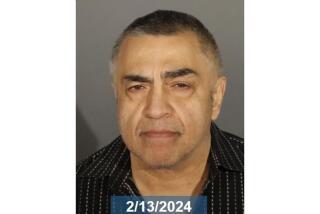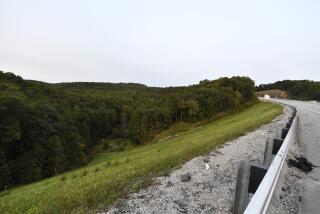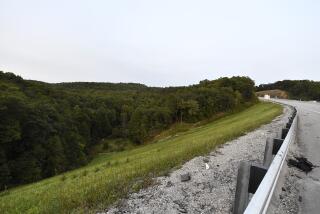FBI makes a connection between long-haul truckers, serial killings
The FBI suspects that serial killers working as long-haul truckers are responsible for the slayings of hundreds of prostitutes, hitchhikers and stranded motorists whose bodies have been dumped near highways over the last three decades.
Federal authorities first made the connection about five years ago while helping police link a trucker to a string of unsolved killings along Interstate 40 in Oklahoma and several other states. After that, the FBI launched the Highway Serial Killings Initiative to track suspicious slayings and suspect truckers.
A computer database maintained by the FBI has grown to include information on more than 500 female crime victims, most of whom were killed and their bodies discarded at truck stops, motels and other locations along popular trucking routes crisscrossing the U.S.
The database also has information on scores of truckers who’ve been charged with killings or rapes committed near highways or who are suspects in such crimes, officials said. Authorities said they do not have statistics on whether driving trucks ranks high on the list of occupations of known serial killers.
But the pattern in roadside body dumps and other evidence has prompted many investigators to speculate that the mobility, lack of supervision and access to potential victims that come with the job make it a good cover for someone inclined to kill.
“You’ve got a mobile crime scene,” one investigator said. “You can pick a girl up on the East Coast, kill her two states away and then dump her three states after that.”
Although some local police agencies have been briefed on the program, the FBI had not publicized its existence outside law enforcement until earlier this year, when officials agreed to show The Times the inner workings of the operation and share details of some of their cases.
Housed in a nondescript brick building on the outskirts of Washington, D.C., FBI analysts pore over reports and computer entries looking for patterns in slayings from California to Connecticut.
Since the program began, more than two dozen killings have been solved, authorities said.
Michael Harrigan, who oversees the Highway Serial Killings Initiative, said the program helps local police “connect the dots” to slayings outside their jurisdictions. He said most of the victims led high-risk lifestyles that left them particularly vulnerable.
“We don’t want to scare the public and make it seem like every time you stop for gas you should look over your shoulder,” Harrigan said. “Many of these victims made poor choices, but that doesn’t mean they deserved to die.”
Though most of the entries in the database pertain to unsolved slayings, cases that authorities consider “cleared,” or solved, remain in it so that investigators may potentially link additional crimes to a known perpetrator. There are also entries on sexual assaults and missing-person cases linked to highway locations. FBI officials declined to provide The Times with a more detailed breakdown of the database’s contents.
The program’s success depends largely on local police departments’ voluntarily providing data on seemingly random killings, sexual assaults and other violent crimes to the FBI, where it is stored in a massive computer database. FBI analysts can query the computer to spot patterns that might otherwise go unnoticed.
This was exactly the kind of help Terri Turner was looking for when she turned to the FBI in early 2004. Turner, a senior criminal intelligence analyst with the Oklahoma Bureau of Investigation, was working on a string of seven slayings along I-40 in which the victims were truck-stop prostitutes who had been killed and left at roadside locations.
Turner’s inquiry was given to an analyst with the FBI’s Violent Criminal Apprehension Program, which maintains the agency’s crime database. The analyst found that the database contained more than 250 cases of roadside female crime victims, many of them bearing enough similarities to suggest patterns in the violence. Subsequent searches and Internet research bumped the number to 350. As a result, bureau officials created a separate computer database to track such crimes and assigned an analyst to work full time on the serial killer program.
Later that year, Turner’s suspected killer was identified as John Robert Williams, a 28-year-old trucker.
Williams and his girlfriend had kidnapped a woman from a casino in Mississippi, killed her and dumped her body along a rural county road, authorities said. Concerned that they’d been seen leaving the casino with the victim, Williams’ girlfriend panicked and called police, telling them that she and Williams had found the body. Their story quickly unraveled, and the pair were arrested for murder.
During subsequent interrogations, police said Williams confessed to more than a dozen slayings -- including many of the cases Turner had been investigating. He had detailed knowledge of how the crimes had been committed, such as whether the women were killed by manual strangulation or with the use of a ligature, according to authorities. He explained how some had been sexually assaulted, in some cases after they were dead, they said.
Williams knew, for example, that one victim, Buffie Rae Brawley, had the word “Ebony” tattooed on her right thigh, investigators said. And he knew that the truck-stop prostitute had deep lacerations on her head, which he said she suffered when he struck her with a “tire thumper,” a trucker’s tool used to bounce off truck tires to gauge their pressure.
Police said Williams told them that Brawley solicited him for sex at a truck stop in Indianapolis.
“The second she tapped on my window, she was a dead woman,” one investigator quoted the trucker as saying.
Williams has since recanted his confession, and there is no DNA linking him to any of the slayings. But Sgt. Larry Hallmark of the Grapevine, Texas, Police Department said he and other investigators do not believe that Williams’ confession was bogus.
“He actually bragged that we wouldn’t find any DNA because he didn’t have sex with them in the traditional sense,” said Hallmark, who interviewed Williams several times and has submitted a potential death penalty case to the district attorney in his county outside Dallas.
Hallmark said investigators from other jurisdictions “are kind of waiting in line” to see what happens with his case.
The investigator of Brawley’s death is among them.
“We’re about 10th in line,” said Capt. Clarke Fine of Hendricks County, Ind. “I figure if Texas fries him, we’re good.”
--
Spotting patterns
For the most part, the FBI analysts assigned to the serial killer program have spent their time combing through crime data that is months or even years old for patterns that might link slayings to one another or to a suspect. But occasionally, they have spotted patterns as they were actually occurring. That was the case two years ago when authorities noticed that dead prostitutes who had been shot with a .22-caliber gun were being found along highways in Georgia and Tennessee.
The body of one victim, Sara Hulbert, was found behind a truck stop in Nashville.
Sgt. Pat Postiglione, a veteran homicide investigator with the Nashville Police Department, was assigned the case. He called the FBI and learned that Hulbert’s killing fit a pattern of recent slayings and might have been the work of serial killer, something he’d already suspected.
With little to go on, he and another detective began reviewing videotape taken at the Truck Stops of America site in downtown Nashville where the victim had been found. It was mind-numbing stuff: big rigs pulling in and out of one of the busiest truck stops in the state, like planes taking off and landing at LAX.
The only thing that caught Postiglione’s eye was a yellow 18-wheeler that seemed to come and go within about 30 minutes. The interval seemed short compared with that of other truckers, who spent at least an hour -- or even several -- as they fueled up, ate and maybe slept for a while.
As leads go, it was pretty thin. But then the detective got lucky. As Postiglione approached the truck stop the morning after watching the tape, he said, he saw what he thought was the yellow rig heading toward a nearby area of East Nashville known for prostitution.
Postiglione said he followed as the driver slowly wheeled his truck down streets lined with warehouses, budget motels and liquor stores. After a few minutes, the driver returned to the truck stop and parked, he said.
His curiosity piqued, Postiglione approached the driver’s door and knocked. After a few seconds, a disheveled-looking man emerged from the cab, the detective said.
His name was Bruce Mendenhall. He was of average height and build with a sort of pinched face. His shirt was unbuttoned and he wore no shoes. As Postiglione sized him up, he said he noticed a speck of blood on the man’s thumb and what he thought were several corresponding drops on the driver’s door of the truck.
Though there could have been many reasonable explanations for the blood, Postiglione said, he was suspicious.
“Something -- I don’t know if it was instinct or whatever -- was telling me, ‘Don’t let this guy leave before I look in his truck,’ ” the detective recalled.
According to Postiglione, Mendenhall calmly agreed to submit to a DNA swab and signed a consent form granting the detective permission to search the truck.
The officer said he stepped up into the cavernous cab, large enough to stand up in and walk around. He took a couple of steps into the sleeper compartment and sat down on the bed. To his left, behind the driver’s seat, was a plastic bag. In it was some women’s clothing covered in blood, he said. Also recovered from the cab were a cellphone and an ATM card belonging to a young woman who had gone missing in Indianapolis just 12 hours earlier, authorities said. She has not been heard from since and is presumed dead.
By the time crime-scene technicians were finished with the cab, authorities have said, they had found blood or DNA linking Mendenhall to at least seven victims. He has since been charged with four slayings, officials said. Mendenhall has pleaded not guilty and is awaiting trial in Nashville.
Postiglione said the timeline the FBI put together showed that the intervals between killings were getting shorter and shorter.
“He was spiraling out of control,” the detective said.
--
Other targets
Not all the victims attributed to alleged serial killer truck drivers have been prostitutes whose work made them easy targets. About a month after Mendenhall’s arrest, another long-haul trucker, Adam Leroy Lane, parked his rig in a suburban Boston neighborhood and slipped through an unlocked door into the home of Kevin and Jeannie McDonough.
The McDonoughs were lying in bed when they heard a whimper from the adjacent bedroom where their 15-year-old daughter, Shea, had been sleeping. They went to see what was wrong and found a masked figure holding a knife to their daughter’s throat. Kevin McDonough, a slight but muscular utility contractor, grabbed the intruder, applied a chokehold and wrestled him to the floor. His wife grabbed the knife.
When police arrived, they discovered that Lane was armed with three knives, a length of wire and a martial arts throwing star. In the cab of his truck was a DVD titled “Hunting Humans,” about a serial killer.
A Massachusetts state trooper who earlier that year had attended an FBI presentation in Reno about the serial killer program sent an e-mail to the bureau.
“I just want to make sure this guy is on your radar,” the trooper wrote.
That message ultimately led to Lane’s being connected to slayings in two other states, for which he is awaiting trial. He pleaded guilty to the Massachusetts charges and was sentenced to 50 years in state prison.
J. Patrick Barnes, a New Jersey prosecutor who charged Lane with one of the murders, said the FBI was instrumental in helping solve his case.
“We’re so busy looking at cases in our own towns, our own counties and our own regions that we sometimes miss what’s going on around us,” Barnes said.
“You can’t connect the dots if you don’t know what the dots are.”
--
Access to a database
Hanging in a cubicle in the FBI office near Quantico, Va., is a map of the United States. It’s covered in red dots representing some of the 500-plus cases in the Highway Serial Killings Initiative database. For all the crimes they represent, FBI supervisory agent John Molnar said he thinks the number of such offenses has been “grossly underreported.”
Molnar said he hopes that will change in the wake of a decision last year to make the database available to law enforcement officials online, allowing police with a password to submit case information and make their own queries.
Though many of the dots on the map now appear connected to one another by similarities -- such as the killers’ modes of operation -- the vast majority are not connected to any known suspect.
They are potential serial slayings waiting to be solved, the FBI says.
One involves the 2005 discovery of a decomposing human leg by ATV riders roaring through the woods near Interstate 55 in central Illinois. Painted toenails suggested that the leg, and another discovered nearby, belonged to a woman. But with little else to go on, the case went cold.
Three years later, an FBI analyst used a partial tattoo on one of the legs to help state police link the remains to Lindsay Harris, a 21-year-old call girl who had vanished from the Las Vegas Strip -- some 1,400 miles away -- about two weeks before the limbs were found.
She was the third Las Vegas sex worker whose dismembered remains were found along a highway from 2003 to 2005, prompting authorities to speculate that a trucker or someone else who frequents the highways was responsible for the slayings.
A fourth young woman who disappeared from the Strip and is presumed dead is also thought be part of the pattern. Her remains have not been recovered.
Mike Jennings, the Illinois State Police special agent who worked with the FBI to identify Harris’ remains, said he plans to retire in a couple of years and that the case of the fourth woman will weigh heavily on his mind if it remains unsolved.
“My gut feeling,” Jeninngs said, “is that it’s a trucker.”
--
More to Read
Sign up for Essential California
The most important California stories and recommendations in your inbox every morning.
You may occasionally receive promotional content from the Los Angeles Times.











